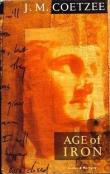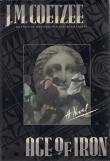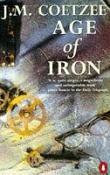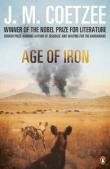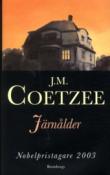AustLit
Latest Issues
AbstractHistoryArchive Description
'Nobel Laureate and two-time Booker prize-winning author of Disgrace and The Life and Times of Michael K, J. M. Coetzee tells the remarkable story of a nation gripped in brutal apartheid in his Sunday Express Book of the Year award-winner Age of Iron. In Cape Town, South Africa, an elderly classics professor writes a letter to her distant daughter, recounting the strange and disturbing events of her dying days. She has been opposed to the lies and the brutality of apartheid all her life, but now she finds herself coming face to face with its true horrors: the hounding by the police of her servant's son, the burning of a nearby black township, the murder by security forces of a teenage activist who seeks refuge in her house. Through it all, her only companion, the only person to whom she can confess her mounting anger and despair, is a homeless man who one day appears on her doorstep' (Source: Libraries Australia).
Notes
-
Dedication:
For
V.H.M.C. (1904-1985)
Z.C. (1912-1988)
N.G.C. (1966-1989)
-
Editions and translations have been updated for Age of Iron by Eilish Copelin as part of a Semester 2, 2013 scholar's internship. The selection and inclusion of these editions and translations was based on their availability through Australian libraries, namely through the search facilities of Libraries Australia and Trove (National Library of Australia).
Given the international popularity of Coetzee's work, however, this record is not yet comprehensive. Editions and translations not widely available in Australia may not have been indexed. Furthermore, due to the enormous breadth of critical material on Coetzee's work, indexing of secondary sources is also not complete.
Publication Details of Only Known VersionEarliest 2 Known Versions of
Other Formats
- Sound recording.
Works about this Work
-
Age of Iron
2023
single work
criticism
— Appears in: The Bloomsbury Handbook to J. M. Coetzee 2023; (p. 127-136) -
“The Origins of Speech Lie in Song” : Music as Language in Coetzee’s Age of Iron
2020
single work
criticism
— Appears in: Le Simplegadi , no. 20 2020; (p. 26-34) 'In Disgrace, David Lurie finds preposterous the proposition that “Human society has created language in order that we may communicate our thoughts, feelings and intentions to each other”, privately believing that, on the contrary, “the origins of speech lie in song” (Coetzee 2000: 3-4). In my 2010 book J. M. Coetzee and the Power of Narrative, I included a brief survey of references to music as a type of language in Coetzee’s work. In this paper I will examine my claim in greater depth, seeking musical resonances in his novel Age of Iron, both in his prose and in the form and structure of the novel. I will attempt to account for my impression that despite his reputation for spare, academic prose, Coetzee is a lyrical and impassioned writer, and that musical rhythms and structures are an essential element in his work.' (Publication abstract) -
Coetzee and Wicomb : Writers Giving an Account of Themselves in Age of Iron and October
2018
single work
criticism
— Appears in: Australian Literary Studies , February vol. 33 no. 1 2018;'J. M. Coetzee’s Age of Iron and Zoë Wicomb’s October feature female writers who are also academics giving an account of themselves through an autobiographical project engaging the genres, respectively, of the epistle and the memoir. While the aim is, ostensibly, to reach an understanding of the historically situated self – Mrs Curren in state-of-emergency apartheid South Africa and Mercia Murray in a conflicted family history – each narrative is punctuated with moments of profound self-questioning with answers, if any are attempted, formulated only as conditional and deferred. This article argues that Mrs Curren’s and Mercia’s ‘incoherencies’, what Judith Butler in Giving an Account of Oneself calls ‘moments of interruption, stoppage, open-endedness . . . enigmatic articulations that cannot easily be translated into narrative form’ signal each writer’s increasing awareness that she is ‘implicated, beholden, derived, sustained by a social world’ (64) that renders impossible fully knowing both the self and the other and includes her dispossession in the very language with which she attempts to represent herself. It is significant, I claim, that each novel stages an encounter with the figure of the other – Vercueil in Age of Iron and Sylvie in October – that is mediated through a non-linguistic art form, namely music and photography. Temporarily revealing the opacities created by each writer’s normative framework, these scenes demonstrate the possibility of a full responsiveness to and experience of knowing the other that cannot, however, be narrated.' (Publication abstract)
-
Eurydice’s Curse : J. M. Coetzee and the Prospect of Death
2018
single work
criticism
— Appears in: Australian Literary Studies , February vol. 33 no. 1 2018;'The prospect of death is one of J. M. Coetzee’s central and enduring concerns. As David Attwell observes in his biography, ‘The most trenchant of the purposes of Coetzee’s metafiction . . . is that it is a means whereby he challenges himself with sharply existential questions’. My claim in this essay is that Coetzee uses the act of writing existentially to orient himself and his readers to the prospect of death. I argue that Coetzee treats the myth of Orpheus and Eurydice as a story about how to deal with the prospect of death. What seems to terrify the Coetzeean protagonist is the thought of the absolute solitariness of death. I call this the curse of Eurydice. Eurydice’s fate in the myth is to be left alone in the Underworld, dying for a second time after her impatient lover turns to gaze at her before they have safely reached the surface of the earth. To take Eurydice’s point of view in the story is to begin to glimpse the solitariness of death. One of the roles of women in Coetzee’s fiction, I suggest, is to mitigate the male character’s fear of this solitariness by conducting him to the threshold of death, but no further.' (Publication abstract)
-
J. M. Coetzee’s Age of Iron and the Poetics of Resistance
2017
single work
criticism
— Appears in: The Journal of Commonwealth Literature , March vol. 52 no. 1 2017; (p. 70-83)'Since the beginning of his career, J. M. Coetzee’s writing has occupied an uneasy threshold between the literary ideals of European modernism, with its emphasis on aesthetic autonomy, and the demands of socio-historical accountability that derives from his background as a South African novelist. This article revisits one of Coetzee’s novels in which these tensions come to the fore most explicitly, namely Age of Iron, to argue that it is precisely from the generative friction that arises between these two opposing fields that his writing draws its singularly affective force. I begin by considering the agonistic relationship between transcendent ideals and socio-material demands that marks Coetzee’s account of the classic (“What is a Classic?: A Lecture”), describing it as a defining feature of his literary sensibility. The article then moves on to a reading of Age of Iron that focuses on the protagonist Mrs Curren’s efforts, in the midst of the violent political struggle in apartheid South Africa, to speak in her own voice. My thoughts conclude with the suggestion that Coetzee’s perennial staging of the conflict between a desire for autonomous expression and a socio-historical milieu that is indifferent to that desire can be read as an imaginative form of resistance, in the field of literary expression, to both the pressures of historical determinism and the dangers of postmodern insularity.' (Publication abstract)
-
‘“How Shall I be Saved?” The Salvation of Mrs Curren in Coetzee’s Age of Iron.
2013
single work
— Appears in: Transnational Literature , November vol. 6 no. 1 2013;In announcing the selection of J. M. Coetzee as the Nobel Prize laureate in literature for 2003, the Swedish Academy wrote that Coetzee’s works follow a recurring pattern: an investigation into the ‘the downward spiralling journeys he considers necessary for the salvation of his characters.’ Though salvation is a strong motif in Coetzee’s novels, explicit connection with Christian salvation is avoided in virtually all of his novels, except for one, Age of Iron. Oddly, however, Age of Iron has been viewed from just about every lens but the Christian one. Susan VanZanten Gallagher and others have correctly noted that Mrs Curren, the novel’s central protagonist, serves as a human allegory for the plight of South Africa. VanZanten Gallagher’s analysis notes references to Virgil and ‘the unborn dead,’ Charon, Dante’s boatman at the river Styx, Hawthorne’s The Scarlet Letter, and Tolstoy’s ‘What Men Live By.’ In a later work she includes Age of Iron in the category of South African confessional literature, but provides no analysis and discussion of how the work fits in the genre. Derek Attridge writes that the role of the ‘other’ in Coetzee’s work, particularly Age of Iron, is key to understanding the author’s writing. For Attridge the conjoined interaction of self and the ‘other’ lead to a recognition of perspective. Although he acknowledges that recognition of the ‘other’ in religious work is transcendent, Attridge does not seem to appreciate fully the role of Christian scripture in Age of Iron. Gilbert Yeoh focuses his attention on ‘love,’ with emphasis on such distinctions as ‘agape’ and ‘caritas’ to explore ironies. Acknowledging the Christian apparatus, however, Yeoh connects Mrs Curren’s ordeal to I Corinthians and ignores obvious allusions to the broader Biblical context. Yeoh appropriates the language of Christianity, but is not attentive to what I regard as the predominant Christian imagery contained in the novel. (Author's introduction)
-
“What Used to Lie Outside the Frame” : Boundaries of Photography, Subjectivity and Fiction in Three Novels by J.M. Coetzee
2013
single work
criticism
— Appears in: Journal of Literary Studies , vol. 29 no. 4 2013; (p. 58-79) 'The concept of frame and its inherent tensions, as addressed by contemporary thinking, is the theoretical focus of this article, which examines representations of photography in three of J.M. Coetzee’s novels (Dusklands ([1974]1983), Age of Iron (1990) and Slow Man (2005)). Photography is treated as a site where Coetzee explores the issues that preoccupy him throughout his work: subjectivity, its boundaries and the possibility of intersubjectivity in relation to the very act of storytelling. The article offers a metaphorical reading of such elements of photography as the blow-up, the negative and digital photography in order to reflect upon Coetzee’s engagement with the possibility of openness to transformation, otherness and futurity implied by both the photographic frame and intersubjectivity in life as well as in fiction.' (Author's abstract) -
Miguel de Cervantes and J.M. Coetzee : An Unacknowledged Paternity
2013
single work
criticism
— Appears in: Journal of Literary Studies , vol. 29 no. 4 2013; (p. 80-97) 'This article points to the 17th-century Spanish writer, Miguel de Cervantes, as one important literary predecessor of the contemporary South African writer, J.M. Coetzee, a relation that has generally passed unnoticed among critics. This relation is brought to the foreground in Coetzee’s most recent novel, The Childhood of Jesus (2013), but it also underlies his previous ones, Age of Iron (1998), Disgrace (2000), and Slow Man (2005), as well as his critical pieces, “The Novel Today” (1988) and the “Jerusalem Prize Acceptance Speech” (1992b), all of which contain echoes of Cervantes’s masterpiece, Don Quixote ([1605, 1615]2005). My argument is that the conflict between imagination and reality, the novel and history, central in Coetzee’s fictional and non-fictional production, needs to be re-examined as a fundamentally Cervantine one. The adventures and fate of Don Quixote lie behind Coetzee’s exploration of whether literature may be an effective and ethical guide in our dealings with reality, whether the ordinary may be transformed into the extraordinary, and of the relation between the literary imagination and the onslaughts of the real world.' (Publisher's blurb) -
[From] Whom This Writing Then?” Politics, Aesthetics, and the Personal in Coetzee’s Age of Iron
2014
single work
criticism
— Appears in: Approaches to Teaching Coetzee's Disgrace and Other Works 2014; (p. 96-104) -
J. M. Coetzee’s Age of Iron and the Poetics of Resistance
2017
single work
criticism
— Appears in: The Journal of Commonwealth Literature , March vol. 52 no. 1 2017; (p. 70-83)'Since the beginning of his career, J. M. Coetzee’s writing has occupied an uneasy threshold between the literary ideals of European modernism, with its emphasis on aesthetic autonomy, and the demands of socio-historical accountability that derives from his background as a South African novelist. This article revisits one of Coetzee’s novels in which these tensions come to the fore most explicitly, namely Age of Iron, to argue that it is precisely from the generative friction that arises between these two opposing fields that his writing draws its singularly affective force. I begin by considering the agonistic relationship between transcendent ideals and socio-material demands that marks Coetzee’s account of the classic (“What is a Classic?: A Lecture”), describing it as a defining feature of his literary sensibility. The article then moves on to a reading of Age of Iron that focuses on the protagonist Mrs Curren’s efforts, in the midst of the violent political struggle in apartheid South Africa, to speak in her own voice. My thoughts conclude with the suggestion that Coetzee’s perennial staging of the conflict between a desire for autonomous expression and a socio-historical milieu that is indifferent to that desire can be read as an imaginative form of resistance, in the field of literary expression, to both the pressures of historical determinism and the dangers of postmodern insularity.' (Publication abstract)
Awards
-
cSouth Africa,cSouthern Africa, Africa,

